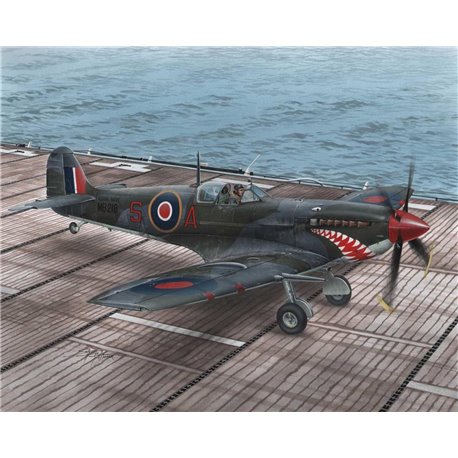No products
 View larger
View larger Supermarine Seafire Mk.II "Torch & Avalanche" - 1/48
SH48102
New product
Supermarine Seafire Mk.II "Torch & Avalanche"
Weight 0.3795 kg
Era Word War II
Origin british
Scale 1/48
You can build different versions with the content of this box:
- Seafire Mk.IIC, MB156/06-F, pilot Sub. Lt. J.D. Buchanan, No. 885 NAS, HMS Formidable, November 1942.
- Seafire Mk.IIC, MB156/06-F, pilot Sub. Lt. J.D. Buchanan, No. 885 NAS, HMS Formidable, December 1942.
- Seafire L Mk.IIC, LR642/8-M, No. 807 NAS, HMS Battler, September 1943.
- Seafire Mk.IIC, MB218/S-A, pilot Major Al. Wright, RM, No. 809 NAS, HMS Unicorn, September 1943.
Wingspan: 11.23 m, Length: 9.21 m, Max. Speed at Sea level: 533 kmh, at 1830 m: 560 kmh, Climb to 1525 m: 1.9 min, Range: 825 km, Service Ceiling: 7 315 m
This product is no longer in stock
More info
Supermarine Seafire Mk.II "Torch & Avalanche"
Weight 0.3795 kg
Era Word War II
Origin british
Scale 1/48
You can build different versions with the content of this box:
- Seafire Mk.IIC, MB156/06-F, pilot Sub. Lt. J.D. Buchanan, No. 885 NAS, HMS Formidable, November 1942. Illustration of the MB156 during the “Operation Torch” the landing in North Africa.
- Seafire Mk.IIC, MB156/06-F, pilot Sub. Lt. J.D. Buchanan, No. 885 NAS, HMS Formidable, December 1942. MB218 was produced by Supermarine. It was equipped with three-bladed propeller and wore Temperate Sea Scheme camouflage. No 885 NAS Spitfire's speciality was the using of Sky band as of
the RAF Fighter Command fighters. Sub. Lt. J.D. Buchanan scored the first Seafire victory (together with his number two Sub. Lt. A. S. Long flying in Seafire MB146). - Seafire L Mk.IIC, LR642/8-M, No. 807 NAS, HMS Battler, September 1943. LR642 was produced by Westland. It was equipped with four-bladed propeller and newer version of elevator and stabilizer. The references differ in used camouflage colors. Either it was sprayed with naval colors or Day Fighter Scheme colors. It is certain though that the camouflage color under the port fuselage M letter and serial number was repaired by two lighter shades of grey. The aircraft participated in “Operation Avalanche” Salerno landing. During one carrier landing the machine crash landed and ended nosed over. Though heavily damaged, it was repaired and flew again.
- Seafire Mk.IIC, MB218/S-A, pilot Major Al. Wright, RM, No. 809 NAS, HMS Unicorn, September 1943. MB218 was produced by Supermarine. It was equipped with four-bladed propeller, clipped wing and wore Temperate Sea Scheme camouflage. The toothed mouth is unusual marking for any FFA aircraft. Moreover, the panel lines aft the canopy's rear part was taped over. The aircraft participated in “Operation Avalanche” Salerno landing. It was damaged during one landing.
History
In the break of 1939 and 1940 Admiralty decided to order naval version of Spitfire that should feature folding wings. Supermarine Type 338 Project was to be powered by Griffon engine and the wings should fold up along the fuselage. The order for 50 aircraft was cancelled since Great Britain hardly needed every Spitfire Mk.I. Naval pilots finally received their Seafires (code name for the naval version of Spitfire) with folding wings much later. The first 48 Spitfire Mk.VBs was modified by addition of landing hook and naval radio set into so called Hooked Spitfires. These machines served for training purposes only. The onwards machines were fully equipped for carrier service. These machines were modified from Spitfire Mk.VB and designated Seafire Mk.IB. When the production had been switched to Mk.VC also new version of Seafire, this time designated Mk.IIC was originated. According to the engine used, particular versions were designated L Mk.IIC for low altitude fighter, standard altitude Mk.IIC and fighter reconnaissance LR Mk.IIC. Royal Navy deployed these versions during landings in Africa and Italy but also during Atlantic and later Indian Ocean missions. Seafire Mk.II was powerful fighter but limited in range and by fragile undercarriage. Also, the carrier handling was limited by non folding wing and therefore version Mk.II was subsequently replaced by Mk.III with folding wing.
Wingspan: 11.23 m, Length: 9.21 m, Max. Speed at Sea level: 533 kmh, at 1830 m: 560 kmh, Climb to 1525 m: 1.9 min, Range: 825 km, Service Ceiling: 7 315 m


